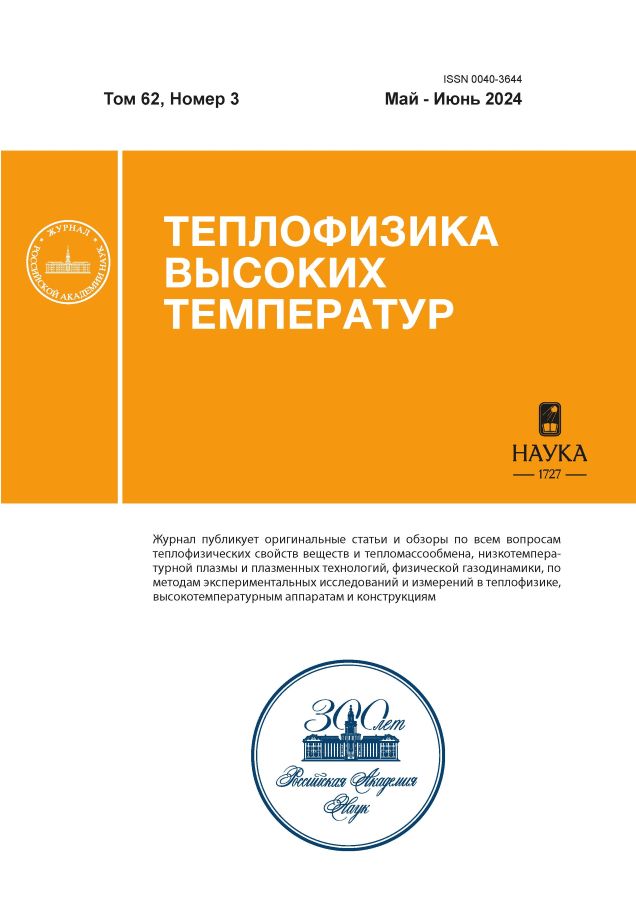Моделирование параметров плазмы двухструйного плазмотрона с промежуточным электродом
- Autores: Петреня Ю.К.1, Фролов В.Я.1, Иванов Д.В.1
-
Afiliações:
- Санкт-Петербургский политехнический университет Петра Великого
- Edição: Volume 62, Nº 3 (2024)
- Páginas: 329 - 340
- Seção: Plasma Investigations
- URL: https://cardiosomatics.ru/0040-3644/article/view/655989
- DOI: https://doi.org/10.31857/S0040364424030025
- ID: 655989
Citar
Texto integral
Resumo
Рассмотрены физические процессы, происходящие при воздействии плазменного потока дуги двухструйного плазмотрона на промежуточный электрод – вращающуюся вокруг своей оси со скоростью 10 тыс. об/мин металлическую заготовку диаметром 5 см. Нагреваемая поверхность металлической заготовки оплавляется, за счет центробежных сил происходит отрыв материала от заготовки в виде капель, после их охлаждения в среде инертного газа получается порошок сферических металлических частиц (PREP-процесс). Этот порошок применяется в аддитивных технологиях. Представлена трехмерная стационарная модель двухструйного плазмотрона с дугой, замыкающейся через промежуточный электрод – вращающуюся металлическую заготовку (приэлектродные процессы не учитываются). Рассмотрено влияние величины тока дуги и расхода плазмообразующего газа на эффективность нагрева заготовки. Представлены как распределенные (температура, скорость плазмы и др.), так и интегральные (мощность в заготовку, мощность потерь на излучение и др.) результаты расчета. Показано, что зависимость мощности в заготовку от расхода плазмообразующего газа имеет «насыщение», т.е. при превышении определенного расхода мощность в заготовку перестает увеличиваться. В этом случае увеличение тока дуги – наиболее эффективный способ увеличения мощности в заготовку.
Texto integral
Sobre autores
Ю. Петреня
Санкт-Петербургский политехнический университет Петра Великого
Email: d.ivanov@spbstu.ru
Rússia, Санкт-Петербург
В. Фролов
Санкт-Петербургский политехнический университет Петра Великого
Email: d.ivanov@spbstu.ru
Rússia, Санкт-Петербург
Д. Иванов
Санкт-Петербургский политехнический университет Петра Великого
Autor responsável pela correspondência
Email: d.ivanov@spbstu.ru
Rússia, Санкт-Петербург
Bibliografia
- Zdujić M., Uskoković D. Production of Atomized Metal and Alloy Powders by the Rotating Electrode Process // Powder Metall Met. Ceram. 1990. V. 29. P. 673.
- Кадыров А.А. Разработка плазменной технологии для получения металлических порошков, используемых в аддитивных технологиях. Дис. … канд. техн. наук. СПб.: СПбПУ, 2020. 116 с.
- Ничипоренко О.С., Найда Ю.И., Медведовский А.Б. Распыленные металлические порошки. Киев: Наукова думка, 1980. 238 с.
- Фролов В.Я., Клубникин В.С., Петров Г.К., Юшин Б.А. Техника и технологии нанесения покрытий. СПб.: Изд-во Политехн. ун-та, 2008. 387 с.
- Электротехнологические промышленные установки / Под ред. Фролова В.Я. СПб.: Изд-во Политехн. ун-та, 2010. 572 с.
- Рутберг Ф.Г., Сафронов А.А., Попов С.Д., Суров А.В., Наконечный Г.В. Многофазные электродуговые плазмотроны переменного тока для плазменных технологий // ТВТ. 2006. Т. 44. № 2. С. 205.
- Сафронов А.А., Васильева О.Б., Дудник Ю.Д., Кузнецов В.Е., Ширяев В.Н. Исследование работы высоковольтных плазмотронов со стержневыми электродами // ТВТ. 2018. Т. 56. № 6. С. 871.
- Colombo V., Ghedini E., Boselli M., Sanibondi P., Concetti A. 3D Static and Time-dependent Modelling of a DC Transferred Arc Twin Torch System // J. Phys. D: Appl. Phys. 2011. V. 44. 194005.
- Boselli M., Gherardi M., Colombo V. 3D Modelling of the Synthesis of Copper Nanoparticles by Means of a DC Transferred Arc Twin Torch Plasma System // J. Phys. D: Appl. Phys. 2019. V. 52. 444001.
- Zhang Z., Sun Q., Wang C., Shui T., Xia W. Numerical Simulation and Experimental Study on a DC Multi-cathode Arc Plasma Generator // Plasma Chem. Plasma Proc. 2023. https://doi.org/10.1007/s11090-023-10377-0.
- Фролов В.Я., Юшин Б.А., Кадыров А.А. Способ получения металлического порошка. Патент на изобретение РФ № 2769116. Кл. МПК-6: B22F9/10; B22F9/14. 28.03.2022.
- Frolov V.Ya., Ivanov D.V., Kadyrov A.A., Yushin B.A. Numerical Simulation of Cooling of Fine Metal Powder in Various Gaseous Environment // Materials. Technologies. Design. 2023. V. 5. № 4(14). P. 115.
- Boulos M.I., Fauchais P.L., Pfender E. Handbook of Thermal Plasmas. Springer Int. Publ., 2023. 1973 p.
- ANSYS Fluent Theory Guide // 2022. https://ansyshelp.ansys.com
- Фролов В.Я., Иванов В.Н., Иванов Д.В. Математические модели плазменных электротехнологических процессов // Электричество. 2018. № 7. С. 54.
- Ivanov D.V., Zverev S.G. Mathematical Simulation of Plasma Processes in a Radio Frequency Inductively Coupled Plasma Torch in ANSYS Fluent and COMSOL Multiphysics Software Packages // IEEE Trans. Plasma Sci. 2022. V. 50. № 6. P. 1700.
- Дресвин С.В., Иванов Д.В. Физика плазмы. СПб.: Изд-во Политехн. ун-та, 2013. 544 с.
- Теория столба электрической дуги / Отв. ред. Энгельшт В.С., Урюков Б.А. Новосибирск: Наука, 1990. 376 с. (Низкотемпературная плазма. Т. 1).
- Иванов Д.В., Зверев С.Г. 3D Model of Plasma Processes in Radio Frequency Inductively Coupled Plasma Torch of 30 kW, 5.28 MHz for Powder Treatment // Вестн. Башкирск. ун-та. 2023. Т. 28. № 3 С. 222.
- Petrenya Y.K., Frolov V.Y., Kriskovets D.S., Yushin B.A., Ivanov D.V. The Influence of Electric Arc Plasma Turbulence on Heat Transfer Processes Involving Powder Materials // Energies. 2023. V. 16. P. 5632.
- Крисковец Д.С., Фролов В.Я., Юшин Б.А. Analysis of the Turbulence Influence in the Electric ARC Plasma Flow by the Laboratory Study Method // Вестн. Башкирск. ун-та. 2023. Т. 28. № 3. С. 242.
Arquivos suplementares




















